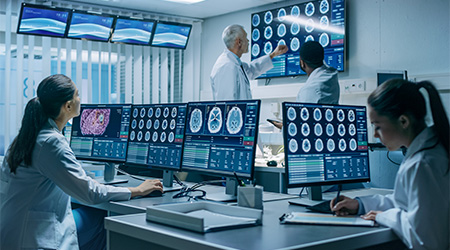Since the onset of the COVID-19 pandemic, hospitals and healthcare facilities have implemented software and technology within their operations. Proving to be an essential tool to these facilities, technology is predicted to continue transforming healthcare facilities. Whether the technology is self-check-in kiosks, robots helping perform surgeries or wireless devices, it is here to stay. In this manufacturer's roundtable, Healthcare Facilities Today talks with technology experts on ways emerging technologies will change healthcare facilities in the coming years.
How has technology transformed the healthcare industry? What ways will software and technology change it in the coming years?
“Technology has transformed the healthcare industry in many different ways. At the patient level, it has helped to make information very accessible. Patient-centered thinking has been driving many of the technology advancements being implemented into healthcare facilities.
The future of healthcare includes technologies that will integrate multiple systems, such as patient's medical history, real-time health updates, insurance coverages and access control management. The ultimate goal will be to use mobile devices as the primary tool to access this information. The end-user experience will continue to drive expansion into these newly digitized areas.”
- Paul P. Cannon, industry leader, Salto Systems Inc.
“From the perspective of serving the older adult population, technology has made significant strides in enabling older adults to be more involved and informed of their personal health and improved access to care with the advancement and diversification of telehealth. The Boomer generation is beginning to age into senior housing with completely different expectations of technology than the former generation. Nearly 80% of Boomers rely on tech to stay connected and 97% of them own at least one smart device (smart phone, tablet, smart TV, etc.). While we’re also seeing this appetite for technology grow in the senior living communities we serve (where the average resident user is 84-years-old), the Boomer demand will change the landscape of senior housing. But what we know is absolutely critical - and also evident in Boomer research - is the need for technology and software to be meaningful and designed with the older adult in mind. Only then will older adults use it and value it.”
— Scott Moody, CEO of K4Connect
“Technology’s greatest impact on healthcare has been to reduce risk and improve the quality of care. Specific to facilities, the pandemic exposed how critical health and safety procedures are to healthcare organizations and the communities they serve. There is a renewed focus on safer access to healthcare facilities, helping to ensure the right people with the right credentials are onsite. For example, technology enables real-time validation of an individual’s credentials. A kiosk can be used to screen and validate a vendor representative’s credentials and confirm that the representatives within a health system are cleared to be there. Health systems will increasingly use online dashboards, mobile credentialing apps, kiosks and data repositories to fully automate the vendor credentialing compliance process.
In the next few years, we will also see the development of technology that can more efficiently move patients through the healthcare experience. In a health system, there are both high- and low-cost care centers (i.e., operating room v. general care unit). For facilities managers, advances in technology will allow them to measure patient throughput from a cost perspective. The data can provide insight into bottlenecks, helping health systems reduce friction in their operational processes to improve the overall experience for patients and their families.”
— Jimmy Hurff, senior vice president, data and analytics, GHX
"In recent years, a significant amount of technology has been developed around life safety and compliance management. Software tools to manage inspections, testing and maintenance, rounding, and other compliance processes seem to have dominated the market. Additionally, energy management and utility cost savings software have seen tremendous growth, as well. I anticipate that future software development will trend towards SAM and use data to drive procedures in a more automated fashion. New software will be developed to serve the maintenance and operations performers, including simplified UIs and integration with BIM mapping and geolocation technology. Traditional CMMS platforms will be replaced with technology centered around AI and smart software.”
— Brian Crum, strategic solution consultant, Dude Solutions
“In some regards, facility management in healthcare can still be a rather analog process, depending on the size and maturity of a particular organization, as well as the financial resources at their disposal for infrastructure and technology investment. Nonetheless, significant advances in building automation, energy monitoring and management, maintenance management, and infrastructure investment capabilities are making it easier and easier for organizations to do so. The future of technology will be focused on data integration, and whoever is able to tie together these otherwise discrete systems and databases will set the new standards for facility management."
— Mark Mochel, strategic account executive, Dude Solutions
“New and more effective technology has enabled healthcare facilities to quickly destroy viruses and bacteria on surfaces within their buildings. As hospitals think about proactively stopping the spread of germs within their facility, they’re looking for fast and effective ways that can be easily implemented. Hospitals worldwide are disinfecting thousands of rooms per day, where each robot disinfects dozens of rooms per day with intense bursts of UV light generated by our patented pulsed xenon technology.”
— Witt Copeland, senior director of sales, Xenex Disinfection Services
Mackenna Moralez is the assistant editor for Healthcare Facilities Today.

 Rethinking Strategies for Construction Success
Rethinking Strategies for Construction Success From Touchless to Total Performance: Healthcare Restroom Design Redefined
From Touchless to Total Performance: Healthcare Restroom Design Redefined New York State Approves $53M Construction Program at Niagara Falls Memorial Medical Center
New York State Approves $53M Construction Program at Niagara Falls Memorial Medical Center How Health Systems Are Rethinking Facilities Amid Margin Pressure
How Health Systems Are Rethinking Facilities Amid Margin Pressure Ground Broken on New Medical Office Building in Scottsdale, AZ
Ground Broken on New Medical Office Building in Scottsdale, AZ